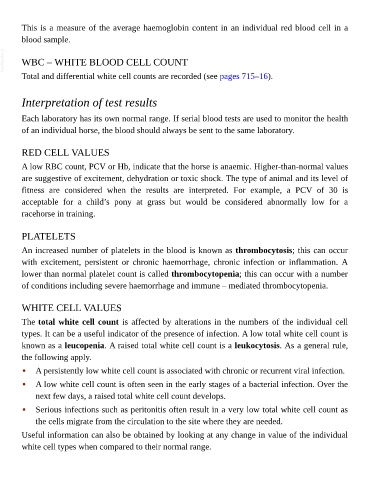Page 1075 - The Veterinary Care of the Horse
P. 1075
This is a measure of the average haemoglobin content in an individual red blood cell in a
blood sample.
VetBooks.ir WBC – WHITE BLOOD CELL COUNT
Total and differential white cell counts are recorded (see pages 715–16).
Interpretation of test results
Each laboratory has its own normal range. If serial blood tests are used to monitor the health
of an individual horse, the blood should always be sent to the same laboratory.
RED CELL VALUES
A low RBC count, PCV or Hb, indicate that the horse is anaemic. Higher-than-normal values
are suggestive of excitement, dehydration or toxic shock. The type of animal and its level of
fitness are considered when the results are interpreted. For example, a PCV of 30 is
acceptable for a child’s pony at grass but would be considered abnormally low for a
racehorse in training.
PLATELETS
An increased number of platelets in the blood is known as thrombocytosis; this can occur
with excitement, persistent or chronic haemorrhage, chronic infection or inflammation. A
lower than normal platelet count is called thrombocytopenia; this can occur with a number
of conditions including severe haemorrhage and immune – mediated thrombocytopenia.
WHITE CELL VALUES
The total white cell count is affected by alterations in the numbers of the individual cell
types. It can be a useful indicator of the presence of infection. A low total white cell count is
known as a leucopenia. A raised total white cell count is a leukocytosis. As a general rule,
the following apply.
• A persistently low white cell count is associated with chronic or recurrent viral infection.
• A low white cell count is often seen in the early stages of a bacterial infection. Over the
next few days, a raised total white cell count develops.
• Serious infections such as peritonitis often result in a very low total white cell count as
the cells migrate from the circulation to the site where they are needed.
Useful information can also be obtained by looking at any change in value of the individual
white cell types when compared to their normal range.

